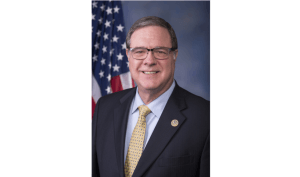Representative Dave Hayes serves as the House Minority Whip as well as the Assistant Ranking Minority Member of the Public Safety Committee. He sat down with The Wire to discuss his priority bill of the session — a crime diversion pilot project. This morning, members of the House Public Safety Committee voted unanimously to send HB 2287 out of committee and onto the House floor.
This interview has been edited for clarity and length.
Emily Boerger: In your words, tell me what this bill is about and why it’s important.
Representative Dave Hayes: The diversion bill as about creating a pilot project, up in Snohomish County specifically to start with. Often times what happens, especially when it comes to opioid addiction, is that in Washington State we have such a shortage of treatment facilities, that there’s sometimes a wait. So what this facility would be used for, is to bring those folks in so even though they might be on a waiting list to get into a treatment program, this will provide a short term housing facility that will stabilize that person and get them on medically-assisted treatment, so they’re not doing the detox stuff out on the street or in the facility. They can detox in the facility, but it’s not meant for that. So, get them on medically-assisted treatment, get them signed up for healthcare, try to address their long-term housing situation, try to address some employment issues, and hopefully keep them out of the emergency rooms.
Because this issue of heroin addiction and overdose is such a problem in Washington State, I feel that Washington needs to make an investment in how we address this issue. The state largely in the past has just left it up to the local jurisdictions to address this. I think there needs to be a state investment. We’re losing more people to addiction overdoses and heroin overdoses than we are to car accidents. That right there is motivation enough for me to go and say to the state of Washington, “we need to do something about this. We need to participate in changing the way law enforcement and human services engages this population.”
EB: Who might be the people who would utilize this center?
DH: The people that are going to be focused on for this program are the highest utilizers of emergency services, the criminal justice system, and the emergency room. So, while it’s truly meant to save lives, it’s also about lowering the rate of recidivism — that revolving door of going in and out of jail and in and out of the emergency room. There’s a significant benefit here not just in saving lives, but also in reducing the burden on criminal justice and the burden on our emergency room services through addressing that community of addiction and mental health.
EB: So why Snohomish County?
DH: The reason Snohomish County is the best place to put this pilot project is because they have a facility that’s ready to go, they just need some help with some operations and operating costs. They have a facility up there that’s a former work release facility. They have 44 beds, both male and female, that would be used as an extension of what’s called the “Office of neighborhoods” within the sheriff’s office. That’s where the embedded social workers work directly with the sheriff’s office and are teamed up with deputies to go out and engage the community of people who are addicted to heroin and opioids and having mental health crisis. And what this facility is for, is to stabilize that person long enough to get them into treatment.
EB: Is that connection between law enforcement and human services underutilized?
DH: I don’t necessarily know that it’s underutilized, but I think the state of Washington doesn’t have the facilities and hasn’t made the capital investment to create treatment facilities for mental health or addiction. So if you go out and talk to an embedded social worker or law enforcement officer who’s working in one of these programs, they’ll tell you, “we just don’t have the programs available. We don’t have the bed space available.” So this program is meant to stabilize that person long enough to get them through the waiting list and into a treatment program.
If you talk to Sheriff Trenary up in Snohomish county or anybody else, those social workers and the deputies assigned to that crew are driving people across the state because Snohomish County doesn’t have a sufficient number of beds. And the state of Washington, in my mind, doesn’t have a sufficient number of beds. So that’s something that we need to work on and I think this is a good way for the state of Washington to start in the right direction to address this issue.
EB: How will you measure the success of a pilot program like this?
DH: The best thing about this bill to me, and what I believe will be the biggest benefit to the state of Washington, is that at the backside of the bill there are four or five metrics called out that Snohomish County will have to report back to WASPC. They will have to report to WASPC on how the program reduces recidivism and use of the emergency rooms, how many people were signed up for treatment, and how many people were successful in treatment.
EB: How much money would this project require?
DH: There’s not specific funding attached to the bill, but I have put in a budget request for $1.5 million. The governor has already dedicated $500,000 in his budget, but I think we need more.
EB: Have you heard any concerns from your colleagues about this bill? Is there anything that might hold it back?
DH: I think this bill is going to do quite well in the House. We have two amendments. One of those amendments has to do with requiring the jurisdiction to carry out the program for two additional years beyond the end of the pilot. The second amendment is likely going to add Spokane so we have an east-west comparison of data there.
The other concern that I understand, and I need to talk with my colleagues in the Senate about this, but the Senate version of this bill, sponsored by Sen. Palumbo was heard in the Senate committee and Senator Darneille and Senator O’Ban had some concerns that they voiced that they don’t believe that Snohomish county is really that unique of a program. So, I need to go over and smooth out that road with them and help them understand why Snohomish County is the best place to start with and what my motivation is for down the road. I want to turn this into a permanent grant program out into the future.
EB: There is a lot of legislation having to do with the opioid crisis this session. Yours seems to be the most holistic one. Would you agree?
DH: Well, I think so. I think we have other folks out there that are coming at this opioid issue from various angles and I think that’s necessary because no one thing is going to address this. When it comes down to having the partnerships between law enforcement and the human services folks, I think that works best to address getting the folks off the street and into the treatment side of it.
But then there’s the prevention side of it. And that prevention side of it is multifaceted as well. We have the health care side when it comes to prescribing opioid medications which I think continues to get a little bit smaller and I think our chief problem now is heroin. Whereas Oxycodone and those opioid prescriptions may have been a pretty significant part of starting the problem, I think that’s shrinking because they’re so expensive to get and heroin is so cheap. So, we also have to interrupt the supply and do some preventive enforcement with that side of it as well.
We need to attack it from every side. So, Representative Cody’s bills and there’s a few other bills out there regarding prescription reporting by the doctors, those are all good bills that I’m going to support as well. There’s no one way to address this. We have to come at it from all different angles because every single addiction scenario is going to be specific to the person that’s suffering.
EB: Any final thoughts you’d like to leave our readers with?
DH: My biggest message here is that first of all, we need to change the way we engage that community. You know, I hear from some constituents, when I talk about this on social media I get comments back about, “you know, we’re making investments in people who have chosen their own path. They’ve chosen their own bad path and they need to dig themselves out.” But I think that this opioid addiction is so different in how it changes people’s minds and changes the structure of the human brain. If we don’t as a community engage them in a different way to give them the ladder to climb out, then they’re not going to be able to because this addiction is so different from other addictions. I’ve said it a few different times; I don’t think there’s a single household in the state of Washington that hasn’t felt the negative effects of this in one way or another. We need to do something about it. And it’s my job as an elected official to do something about it.
Your support matters.
Public service journalism is important today as ever. If you get something from our coverage, please consider making a donation to support our work. Thanks for reading our stuff.











